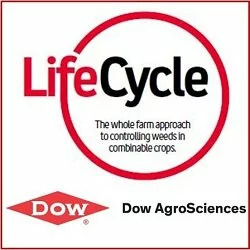Early Harvest Comments
I farm at Abingdon in Oxfordshire on about 2,500 acres with 1,000 milking goats and we also fatten beef cattle. We have around 2,000 acres of arable plus grass and maize, on a range of soil types.
Production is predominantly Winter Wheat (1,200 acres normally) though this year we only managed to get in around 200 acres, on the light land, so have mainly Spring crops this time. In fact we drilled an additional 150 acres of Winter Wheat at the end of February and currently it is looking as though that may do better than that sown in October on the light land. We also have 500 acres of Canadian Red Wheat and 500 acres of Oilseed Rape. Normally that would be winter OSR but we had to replant a fair proportion of it this year so around 2/3 is Spring Rape. A further casualty of the autumn weather was the Winter Beans acreage: we only managed to get in about 70 acres of Winter Beans and have 150 acres of Spring Beans. We also drilled 200 acres of Winter Barley, predominantly on light land. So all in all, as for so many other farmers, it has been an unusual cropping year.
It would appear that yields are going to be down in general, off the light land especially. We harvested our first Winter Wheat (Solstice) in the first week of August, which in a late season was never going to be good and, whilst the milling quality seems pretty reasonable, we had a yield of about 2.5 tonne per acre. With the hot spell, at least the crop ripened evenly, so it could have been worse but it could also have been a great deal better! We took the risk of planting 150 acres of Solstice in February and, if it didn’t vernalize properly, planned to clamp it as whole crop silage and take some of our forage maize through as grain maize instead. However, it did vernalize and I think it will probably yield as well as the autumn sown Solstice on the light land and might conceivably even do better.
Of the Winter Rape we have cut about 100 acres so far with yields under 1 tonne. Considering this was on the light land and the season we have had that is probably about what we could expect but we would normally have had a higher yield. Some of the better bits will undoubtedly do more but the poor patches, due to the weather, will pull the average down. Spring Rape is still some way off harvest and it remains to be seen how that will perform. It will depend whether the rain we have had in the last couple of weeks has been enough and soon enough to have a beneficial effect. My suspicion is that it was too little and too late but time will tell!
We are just about to start combining the Red Wheat (main variety A C Barry) which in harvest terms is probably about normal but, given late planting and the hot dry weather that has ripened it early, I am confident that the yield will not be spectacular. We normally expect 1 to 2 tonnes per acre so will be interested to see how it does. Our second variety, Barlow, is still a few days away so we shall not be into that until next week.
We are now working on getting straw cleared and cultivations done. One thing that is quite pleasant is that we have already baled the straw on the first 200 acres of Winter Wheat and without turning, which is unusual in the last few years There is a reasonable demand for straw in this area particularly as the thinner crops have produced straw yields that are significantly down. We aim to start drilling the rape into the land where the Solstice was at the end of week commencing 19th August, which I feel is about the right timing. Last year we went in early September, which was fine in 2011 but a bit late last year so we hope to go a little earlier to give it as good a start as possible. Variety PR 46W21 did reasonably well for us last year and, as there is little evidence from this year to cause us to change, we shall stick to that.
Our milling wheat is on a Warburton’s contract and we have been growing all Solstice. Next year we plan to move away from that to 1/3 Solstice and 2/3 Crusoe, largely on account of evidence that Crusoe is producing better yields.
I think in many ways we are all looking forward to getting this year’s harvest out of the way, putting it behind us and moving on. The less we dwell on this year’s yields the better really! The interesting thing will be how that will affect us from a financial point of view. I anticipate that the pinch point in cash flow will come next spring (March, April, May) as we have significantly less grain to sell through the winter and unfortunately the reduced costs we incurred last spring were not sufficiently down to balance that out.








 Saving...
Saving...